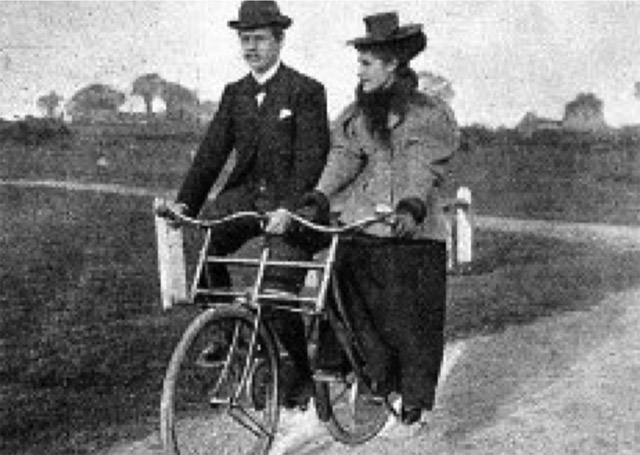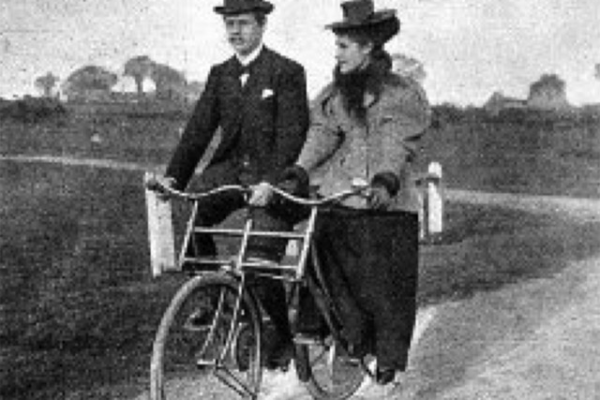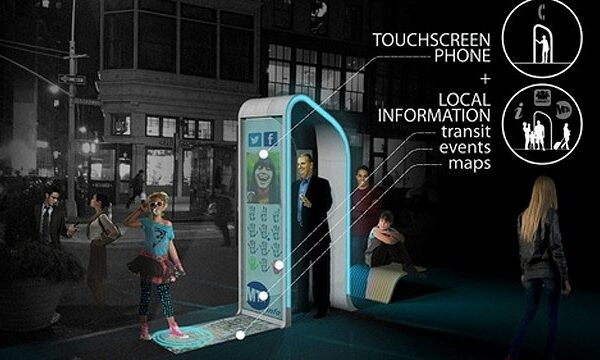In Pursuit of the Perfect All-Weather LEV
Oct 19, 2014. Times Article Viewed: 49086
Bicycles are great, but they have their shortcomings, especially as the weather turns wet and cold. What’s a need to make them viable year-round are creative solutions that meld form and function into the perfect Light Electric Vehicle.

Late 19th-century ‘Socialable’ bicycles put riders side-by-side, unlike tandem bicycles. Modern examples are still being custom made.
While there is almost no image more elegant or romantic than a person simply riding a bike, we are constantly entangled in innumerable schemes to wed us to something grand, a car, a nice big house, which is intended to inflate our sense of self and give us a greater sense of well-being. Seldom displayed is the ragged couple dragging themselves into that home, in that car, the lines of worry etched deeply into their foreheads, trying to figure out how they are going to make the next payment on these behemoths or finance a needed repair. Of course, the second home, or second car, has now entered the picture and how can the Jones’ ever keep up when it is only a matter of time before the next generations appear and begin to assert their right to all that the earth provides without limit? The Merry-Go-Round keeps spinning faster and faster and even historic floods and droughts are not enough to slow it down enough to get on or off without accompanying power failure.
Also see EV World’s interview with William Mulyadi on the Virtue enclosed tricycle featured at the 2014 Interbike show in Las Vegas.
Now that the school year is in full gear it may be instructive to project oneself back into the time when each of us was enrolled in one of these august institutions. Fitted with a book-bag, (now a backpack), we were dropped off, or made our own way, into a crowded classroom filled with kids just like ourselves, wondering if we would be able to do what was expected of us and meanwhile get along with the others. Another big issue was behavior. If the teacher was temporarily absent we spent the time ribbing each other over something trivial, an article of clothing or a new haircut or misspoken word and the wisecracks and teasing went on until the teacher appeared. Often, for at least some of us, that was not enough to stop the errant activity, but soon order was restored and the sound of chalk on slate brought us back into line. Some kids kept it up, as often as not, and had to be shushed or berated to sit down and behave themselves. Restlessness prevailed regardless since kids are naturally energetic and spontaneous until they have been tamed and disciplined into orderly automatons. Slowly, the pressure to conform and fit in is applied and few escape its gravity.
Most of us could not wait until the time between classes when we could have a few minutes to whoop it up and get to the next classroom. This varied from grade to grade and kid to kid and the rules of the school about talking and being restrained in our behavior, but the time gaps between sitting there, and being told not to move around too much and keep quiet and not disturb the class, were precious. Even more important, in the midst of all those calls for self-control, were lunch periods and recesses, where you could move about more freely and express yourself more completely, where you could, in effect, be yourself. Since we are all different and especially when it comes to how we regard and relate to others, this was a unique experience for each of us and could be troubling if you didn’t think you fit in quite right or had problems that few recognized or related to very well. Peer-pressure starts early and has a powerful effect on all of us, although much more on some than others. Going along and doing well is the most important thing for many, while the opposite is true for a significant number of others and these patterns can continue for a lifetime for quite a few.
There are some factors that affect everybody in that class though. You must become comfortable in a seated position, facing forward and being as passive as possible. Sure, you need to answer a question if the teacher has one, although not too eagerly or often or the other kids will think you are a nerd or kiss-ass. Acting or speaking out of turn will earn you a reprimand and really outrageous behavior on a trip to the Principal’s office. If you do it often enough you will get some pills to take and will be regarded henceforth as a troubled child in need of extreme discipline or worse. Order is what matters and going along with the program. There are too many bodies and not enough time to master the essential skills, reading, math, and comprehension, so there is no time or patience for being too spontaneous or expressive. This is a giant Viking ship and all of the oars must be pulled in unison or the voyage will be delayed or misdirected. We are being trained to be little conformists, to find our rightful places and fit in so that needed jobs can get done and good order preserved. Ergonomically awkward sitting down becomes more natural than standing or lying down. Or running.
Consequently, for many, sports becomes an important release. There is the ability to get physical at a time when the body is growing and vigorous activity provides an outlet for the energy that we possess in abundance and is always looking for a channel to express itself. There can be tension too, do you make the team, are you good enough, is your team a winner, but the participation alone is gratifying and healthy if it doesn’t get too competitive. The bad news is that recess is in a recession, takes away valuable time from studying for the standardized tests that teachers and principals are judged on, requires resources that are in short supply and is being eliminated along with the music and art programs that experience shows do so much to motivate and improve attitudes. We are in a death spiral when it comes to providing a really well-rounded education along with the memorization and drills. The impact on our mental health and ability to truly understand who we are and where we want to go in this life are being short-circuited and demolished by one-dimensional measurements and lack of depth in these venues.
Why is it so difficult for this society to get the point about what matters the most and how to reach it? Mostly it comes from a lack of understanding of the nature of society and how it functions. A cab driver from Haiti last week, a hard-working fellow enjoying the music on his radio, commented about the life here and the lack of connections among people. His country, one of the poorest on the planet, with deprivation as common as sunshine, is a wonderful one to him he said because everybody regards each other as family. What is good for you is good for me. Here, we are all in a race, sometimes described as one between rodents, and what benefits your neighbor may mean that it is costing you. The media embraces this message and amplifies it until it is deafening. If your own kid is doing great, that is what matters. If your city’s team is winning you should be happy. If your country’s economy is improving, who cares if the other guys are in trouble. What is missing from the picture is the way in which your economy is dependent upon the other’s, that their problem is soon yours. If the educational system is producing mostly losers, unsuitable for more than the merest tasks and rewards, how long will it be before this malaise undermines your own kid’s fortunes? This lack of connectedness is fatal to the big picture’s health and so-called recessions elsewhere can easily turn into depressions here.
One way in which this process has evolved has to do with the wealth which is now in the hands of different races. We are now aware, following the economic disaster recently barely averted and still poised to swallow us all in its potential aftershocks, that the material holdings of those called “White” people, conventionally those descended from Europeans, is 20 times that of those we call “Blacks” or African-Americans. Latinos are only slightly better off. Is it any wonder that vast swaths of our population regard themselves as persecuted and unfairly treated? Certainly, it does denote a shocking disparity and distance from the egalitarian ideals that we are all taught to embrace and respect as part of the American ideal. Furthermore, does it come as a big surprise that the average person, of any race or nationality, living from week to week and enveloped in insecurity, feel immersed in worry?
Our habitual wasting of the material resources that have been provided to us, (whether or not we deserve them), is nothing compared with the waste of human resources that we perpetually witness every day all around us. It is so considerable that it barely scratches our consciousness. Nowhere is this more obvious than in transportation. Whereas one horsepower is enough to get us where we are going, we expect to have 200-300 to get the job done, without a second thought about all of the resources needed to feed that mighty herd. 80% of the time, only one-sixth of the seating capacity of the vehicle is in use. I can remember many long hours standing by the side of a windy or rainy highway wondering why nobody would consider sharing that empty space with a needy, non-threatening looking civilian with his thumb hanging fruitlessly in mid-air. This machine sits idle 90% of the time and that is alright we compute since it is there when we want it, with nary a thought about who might really need it at that moment. It is giving us a wide variety of maladies, from heart disease to diabetes, kidney malfunctions, and bad backs, but we think it is an unalloyed blessing. We are deluded and living in a fantasy world constructed from TV commercials and smug assumptions of our superiority and dangerous fantasies in regard to the permanence of these conditions.
Lately, I have spent a lot of time making models of tricycles with a variety of features that are missing from our conventional forms of mobility. I wonder why, since we ordinarily avail ourselves of a variety of postures during a given day, from prone to standing, sitting, leaning, maybe even crouching, yet we have been conditioned to sit, the most unhealthy of them all according to medical authorities, almost all of the time. Your car, your desk, your dinner table, and train or bus, all demand that you assume this position and stay there. The conveyances that I am currently construing, permit the widest number of different body positions that are possible. When we get to school, past kindergarten, sitting is the only permitted way to position ourselves. We are not even given the choice between a tall stool and a conventional chair. We may not crouch or stretch out on the floor lest we get “dirty” or encourage undisciplined behavior. It is either follow the rules or get out. Instead of listening to our bodies, which crave some difference in attitude, we are commanded to obey, and we do. There is claimed to be an inner logic to this that we are too young and stupid to understand but really it is just for the convenience of the managers, who want to encourage “responsible” predictable behavior and will enforce their commands without fail.
The second element is the source of the motive power, conventionally either a motor or leg power. To these choices, I would like to add arm power as well. The “Rowcycle” is one example of this and I would add the choice of an electric-assist motor as well. The combination of the three, arm, leg and motor, is superior to any one of them by themselves but is virtually unavailable in any vehicles with the exception of some recumbent and disabled vehicles that use two or more of them in tandem. Why not all three? Because it has not been the rule up to now and we are creatures of habit and captives of the conventions that have been most popular up to now. Some of it is technological since the advent of lithium-ion batteries has now made practical the inclusion of electric-assist motors on primarily human-powered vehicles easy and economical. Mostly it is the difficulty of popularizing any severe variations on what we have been accustomed to. There is no retail marketplace that is available to sell and display and offer free test rides of these variations on the usual, so they are virtually invisible. The internet will change that somewhat but the pace needs to pick up much faster and that will require more ambitious and energetic ways to get the word out.
Two wheels have many advantages over three, most of them based upon the increased efficiency of a single-track vehicle over one with three tracks like a tricycle. These advantages disappear when the need to minimize the weight of the vehicle is reduced due to the addition of the electric-assist motors. Lessening rolling resistance demand high-pressure tires and the increased bumps and shakes produces by the triple-track vehicle make the single-track one vastly superior. But if you can use bigger and softer tires, which are much better at absorbing these imperfections of the roadway, that advantage is more than made up for by the increased stability and utility of a three-wheeled device. Since we have just begun to enjoy these electric-assist motor benefits, the advanced design of these three-wheelers is in an infant stage. Creative designers are just beginning to evolve the slickly-aerodynamicVelomobiles of yesterday, into the comfortable and safe and reasonably-efficient, rather than maximally-efficient conveyances of tomorrow.
Weather protection is an essential feature of any up-to-date vehicle. Rain, hot sun, wind, airborne grit and dust, cold, all discourage riding out in the open all of the time. In order to become the ordinary means of transport, a vehicle must be able to protect the rider against the worst effects of these annoying elements. Nobody expects a car of bus or train to expose the rider to a host of unhealthful and disturbing elements but bike riders assume that this is part of life and unavoidable. Putting an umbrella above a bike is to invite a gust of wind to carry you into oncoming traffic, a dreadful thought. Assuming a lower position, while providing visual signals of the presence of the rider, flags, LEDS floating above, streamers and the like, offer great advantages through a lower center of gravity. Three wheels and an electrical-assist motor and its batteries add weight down low where it contributes the most to safety, and guard against the negative effects of the increased surface area that weather enclosure requires. We have some wonderful weather-resistant and very lightweight materials available today that allow for tight, transparent enclosures to be made that can be easily displaced when not needed, so this improvement in the usability of the vehicle can be deployed only when necessary. No industrial-scale vehicle can offer this kind of variability to the rider. Tiny battery-powered heaters embedded in clothing and body-heat itself can be quite efficient and the rush of air past the body is a form of air-conditioning that has always been there. Shade to block the sun when needed is relatively easy to provide and wind-screen s are easy to deploy on stable tricycles.
The bike is essentially a single-person device. There are tandems but they are rare and require good coordination between riders. We can have side by side or tandem-style multi-person human-powered vehicles that, because they are on a stable three-wheel platform, do not require anything special from the riders. One could even be severely-disabled and it would be of no consequence. Even three or more people could ride on a single vehicle with no problem. We have not seen this very often so we don’t consider it possible but it is not really a problem, just very unusual so we are unaccustomed to the possibility. The multi-person ”Sociables” of the 19th century laid the groundwork for this but have, sadly, subsequently disappeared. We can bring them back and build on that tradition, expand the common bicycle into the vehicle it was meant to be.
All of these improvements in the safety, utility, practicality, and range of features available for muscle-powered, electric-assisted vehicles, primarily futuristic tricycles, are ready to be developed today. They will change the expectations that we have for the most appropriate use of materials and resources that we need to cultivate for our own benefit and survival. It will involve no sacrifice of comfort or other pleasures, in fact, it will enhance our existence, help us to be healthier and more vigorous. It is the reason I am devoting my energies to the development of these possibilities and suggest that you do too.
Times Article Viewed: 49086



